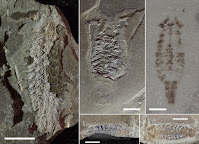 |
| Parioscorpio venator Wendruff, Babcock, Wirkner, Kluessendorf & Mikulic, 2020 in Anderson, Schiffbauer, Jacquet, ... et Mikulic, 2021. DOI: 10.1111/pala.12534 2020. DOI: 10.1038/s41598-019-56010-z |
Abstract
A relatively uncommon arthropod of the Waukesha lagerstätte, Parioscorpio venator, is redescribed as an arthropod bearing a combination of characters that defy ready classification. Diagnostic features include sub‐chelate ‘great appendages’, a lack of antennae, multiramous anterior trunk appendages, filamentous fan‐like rear trunk appendages, and apparently thin and poorly preserved pleural fields. Phylogenetic analysis resolves this organism as basal to crown‐group Mandibulata and Chelicerata, but its exact placement is inconclusive. Thus, we compare its morphology to several stem groups of arthropods in a discussion of its plausible taxonomic affinities. The examined specimens are probably carcasses and preserve a variety of soft‐tissue details, including muscle blocks in the head, eyes and eye facets, likely ventral nerve cords, a central gut tract and trunk legs with multiple filamentous elements organized into stiff bundles. The preservation habits of P. venator are characterized and compared to previous assessments of Waukesha lagerstätte taxa. Four preservation habits are observed: a phosphatized habit showing flattened to partly three‐dimensional mineralization in francolite; a mouldic habit largely left behind by removed francolite that shows no carbon enrichment despite a darkened colour; sheet‐like or speckled carbonaceous compressions; and scattered pyrite crystals. This redescription highlights both the palaeobiological value of ‘small’ lagerstätten typical of the middle Palaeozoic and the caution that must be taken when interpreting their more enigmatic constituents.
Keywords: stem‐group Arthropoda, taphonomy, phosphatization, nerve cord, appendage, morphology, tagma
Evan P. Anderson, James D. Schiffbauer, Sarah M. Jacquet, James C. Lamsdell, Joanne Kluessendorf and Donald G. Mikulic. 2021. Stranger than A Scorpion: A Reassessment of Parioscorpio venator, A problematic Arthropod from the Llandoverian Waukesha Lagerstätte. Palaeontology. DOI: 10.1111/pala.12534
Genus Parioscorpio gen. nov.
Etymology. From Latin, pario, progenitor, and scorpio, scorpion.
Parioscorpio venator gen. et sp. nov.
Etymology. From Latin, venator, hunter.
Types. Holotype, University of Wisconsin Geology Museum, Madison, Wisconsin, UWGM 2162. Paratype,
UWGM 2163.
Location. Waukesha Lime and Stone Company west quarry, north of State Highway 164, Waukesha, Wisconsin,
USA.
Horizon. Lower part of the Brandon Bridge Formation (Silurian: Llandovery, Telychian).
Andrew J. Wendruff, Loren E. Babcock, Christian S. Wirkner, Joanne Kluessendorf and Donald G. Mikulic. 2020. A Silurian ancestral scorpion with fossilised internal anatomy illustrating a pathway to arachnid terrestrialisation. Scientific Reports. 10: 14. DOI: 10.1038/s41598-019-56010-z



